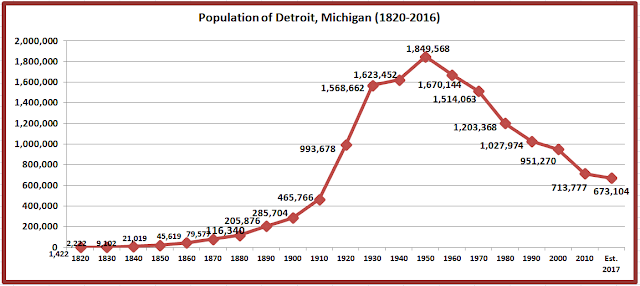Detroit in its heyday
From Retiring Guy's postcard collection
Another double-digit-percentage population loss for the Motor City. Overall, its population is down 65% from its 1950 peak.
The Detroit News, 8/12/2021
Duggan had suggested Detroit would have experienced a leveling by now after annual counts showed a slowing decline from 2010, when the city's population was more than 713,000. But the U.S. Census Bureau put 2020's population tally at 639,111, a drop of 10.5% or almost 75,000 residents from a decade ago, according to data it released Thursday.
It's the seventh straight decade Detroit's population has declined since the census showed the city with nearly 1.85 million residents in 1950.
But Detroit remained Michigan's largest city, followed by Grand Rapids, which grew 5.8% to 188,040 residents. Warren remains the state's third-largest city.After a loss of more than one million residents over the past 70 years, the undercounting argument has lost its effeciveness.
But it's what Detroit officialas do every 10 years.
Original 1/1/2019 post starts here
Detroit's population peaked in 1950 at 1,849,568. Its 2017 estimated population is 673,104 -- a drop of 1,176,464, or 63.6%.
African-Americans comprised 16.2% of Detroit's population in 1950.
No city is an island. The current estimated population of the Detroit metropolitan area is 4,313,002, which is up 0.4% from 2010.
The disappearing cities:
Baltimore, Maryland. (12/30/2018)
ABC News, 3/21/2011
New York Times, 5/2/2000
Detroit's population peaked in 1950 at 1,849,568. Its 2017 estimated population is 673,104 -- a drop of 1,176,464, or 63.6%.
Source: Wikipedia
African-Americans comprised 16.2% of Detroit's population in 1950.
No city is an island. The current estimated population of the Detroit metropolitan area is 4,313,002, which is up 0.4% from 2010.
The disappearing cities:
Baltimore, Maryland. (12/30/2018)









No comments:
Post a Comment